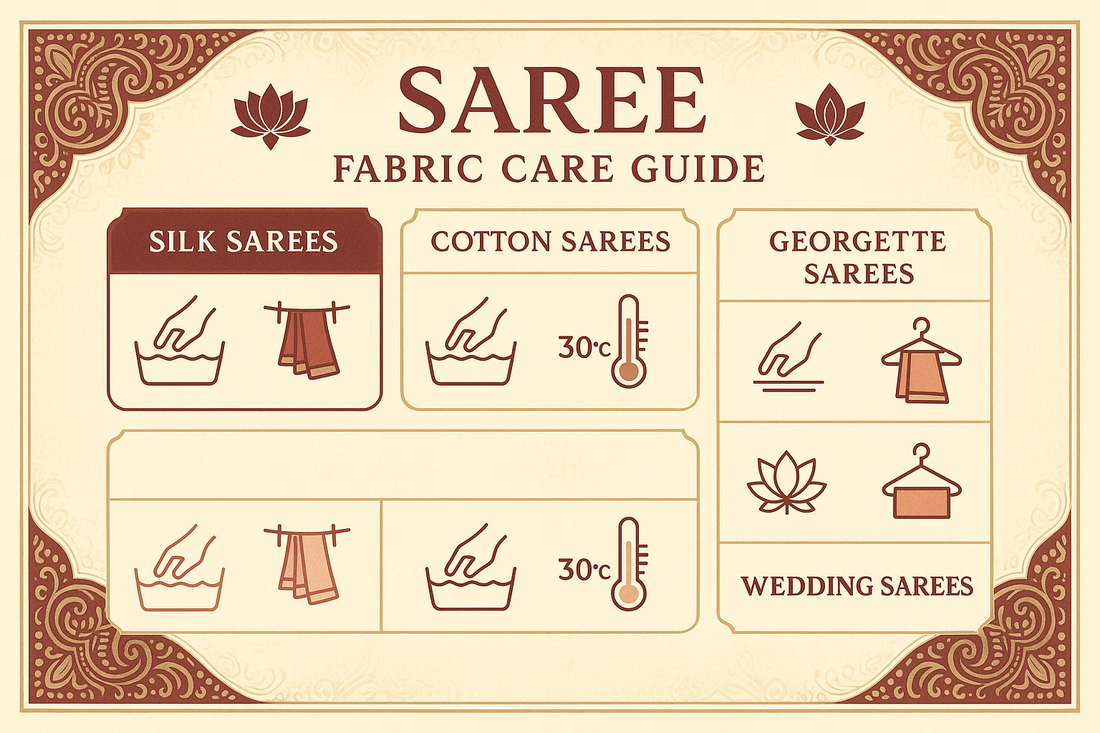
Saree Fabric Care Guide: How to Maintain Silk, Cotton, Georgette & Wedding Sarees
Share
Treatment: A Guide for each Kind
Sarees are not simply standard garments-- they're cultural antiques, fashion statements, and psychological mementos. Whether it's a sparkling silk saree golden hue that transforms heads at wedding celebrations or a contemporary silk saree brand-new layout excellent for cocktail events, each drape requires treatment and interest to protect its charm.
In this comprehensive guide, we dive deep into Saree Fabric Care for every popular type—from silk and chiffon to cotton and georgette—ensuring your saree collection stays pristine for years to come.Phase
1: Why Saree Textile Care Matters
Sarees are delicate and elaborate. A lot of are made from natural fibers or blends that need particular taking care of strategies. Inappropriate treatment can discolor the shades, break fragile threads, and decrease the life of the garment. This is specifically critical for wedding sarees, antique items, and the sareeb collection for wedding events that hold high nostalgic and economic worth.
Correct Fabric Care for Sarees is important not just for long life yet likewise for maintaining the abundant cultural aesthetics they represent.Phase
2: Silk Sarees-- The Royal Fabric
Silk is just one of the most stately textiles, deeply rooted in Indian society. A silk saree gold is not simply attire; it's an event.
How to Care for Silk Sarees:
Dry Clean Only: Constantly go with specialist completely dry cleaning, especially for zari-embroidered sarees.
Storage Tips:
Cover in muslin towel.
Never hang: constantly fold and maintain level.
Avoid straight sunlight to avoid fading.
Folding Strategies: Adjustment folds on a regular basis to prevent permanent creasing or damage along the layer lines.
Pro Idea: Stay clear of splashing fragrance directly on silk sarees-- it can discolor the fabric.
Phase 3: Cotton Sarees-- Classic Convenience:
Cotton sarees are ideal for everyday wear and summer periods. While they are durable, they can shed their quality without proper care.
Taking Care Of Cotton Sarees:
Clean separately in cold water.
Usage moderate cleaning agents.
Starch occasionally to maintain tightness.
Iron on tool heat while damp.
Cotton sarees are flexible and complement a saree with developer blouse to include that modern side.
Phase 4: Georgette and Chiffon Sarees-- Sheer Style
These light and flowy sarees have become celebration favorites. However, they're prone to getting and tearing.
Material Treatment Tips:
Hand wash gently with a soft cleaning agent.
Avoid wringing.
Shop rolled rather than folded to avoid creases.
Iron making use of a steam iron on the most affordable setting.
For a silk saree new layout with georgette blend, always check a small spot prior to cleaning to avoid color blood loss.
Chapter 5: Fabric, Cells, and Net Sarees-- Fragile Beauty:
-
Popular in saree collection for wedding celebration occasions, these sarees add flair and quantity to wedding fashion.
-
How to Maintain Them:
-
Constantly dry clean.
-
Stay clear of hanging for long period of time-- it may stretch the textile.
-
Do not iron directly; make use of a pressing towel or reduced warm steam.
Chapter 6: Banarasi and Kanjeevaram-- Conventional Powerhouses
Banarasi and Kanjeevaram sarees are usually seen in wedding celebration trousseaus. Their abundant structure and heavy zari job make them one-of-a-kind but likewise delicate.
Saree Fabric Treatment Basics:
Shop each saree in a separate muslin pouch.
Stay clear of plastic covers-- they trap wetness.
Re-fold every 2-3 months to avoid wear along the folds.
Use silica gel packages in storage space to maintain dampness at bay.
A silk saree golden Banarasi drape coupled with temple fashion jewelry is evergreen and requires regal treatment.
Chapter 7: Bed Linen and Khadi-- Modest Poise
Bed linen and khadi sarees represent simpleness and sustainability.
Textile Care Tips:
Mild machine clean or hand clean in cold water.
Utilize a fabric softener periodically to avoid rigidity.
Iron while damp.
Pair with a saree with developer blouse or plant top for an Indo-western spin.
Phase 8: Printed Sarees-- Vibrancy that Needs Love
Whether it's blossom prints or abstract art, silk saree brand-new design with digital prints or hand paint are trending.
Taking Care Of Printed Sarees:
Do not soak.
Utilize a pH-neutral detergent.
Remain clear of drying in straight sunshine.
Printed sarees call for fine-tuned like maintain the vibrancy of colors.
Chapter 9: Wedding Celebration & Celebration Sarees-- The Costs Collection
Your saree collection for wedding celebration occasions likely consists of developer developments, handloom prizes, and deluxe fabrics.
Fabric Care for Occasion Sarees:
Always dry tidy initial.
Vapor instead of ironing to avoid shine spots.
Shop with acid-free cells paper between folds up.
Make it a practice to air these sarees every six months to maintain quality and stay clear of mildew.
Chapter 10: How to Shop Sarees Correctly
General Storage Tips for All Saree Kinds:
Stay clear of cable wall mounts.
Store in dark, dry rooms.
Rotate your sarees to avoid irreversible creasing.
Keep naphthalene or neem delegates protect against pests-- yet do not let them touch the material straight.
For costs things like a silk saree gold or delicate net sarees, consider padded saree bags.
Chapter 11: Emergency Spot Cleansing Tips
Usual Stains and Remedies:
Oil/Grease: Usage talcum powder immediately to soak up.
Ink: Dab with alcohol-based solutions like sanitizer.
Wine/Tea: Sprinkle salt and rinse carefully in cold water.
Always area test a hidden section prior to using any kind of solution.
Phase 12: Seasonal Saree Treatment
-
Different seasons bring various obstacles to saree storage space and treatment.
-
Downpour: Usage silica gel packs and completely dry storage space.
-
Summertime: Prevent storing sarees in plastic; use breathable bags.
-
Winter season: Keep away from wet corners and wardrobes.
Phase 13: Travel with Treatment
-
Tips for Traveling with Sarees:
-
Roll rather than layer for light-weight textiles.
-
Usage saree coordinators or transparent pouches.
-
Maintain blouses and devices in labeled zip pouches.
-
Load pricey pieces like a silk saree golden in carry-on bags.
Chapter 14: Must-Have Saree Care Products
-
Moderate pH-balanced detergent
-
Muslin towels and saree bags
-
Steam iron
-
Acid-free cells paper
-
Scent sachets for storage space
Phase 15: Creating Your Saree Care Routine
A saree is a living fabric-- exactly how you treat it establishes the length of time it flourishes. Produce a saree diary if needed to keep track of:
When it was last worn
Last cleaned up or completely dry cleansed
Sort of storage utilized
For high-value things like developer sarees, make it part of your saree with designer closet rotation attentively.
Final thought: Let Your Saree Tradition Live On:
Whether you're building a modern wardrobe loaded with silk saree new style trends or preserving a mommy's saree collection for wedding from decades past, looking after each drape is a sign of respect-- for practice, style, and self-expression.
Every layer holds a story. With proper Saree Fabric Care, you make sure those stories remain to unfold beautifully for generations to come.
Would you like this turned into an SEO-friendly websites with photos, headings, and meta summaries? I can also aid you prepare social networks subtitles or develop infographics based upon this material.
